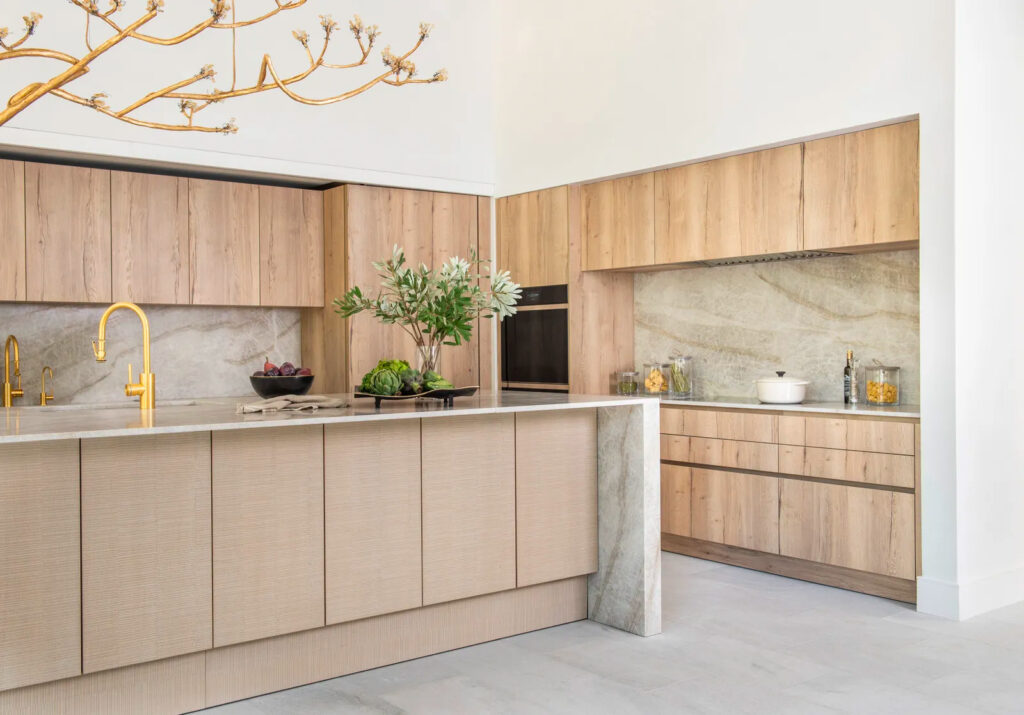7 Designers Share Their Storage Secrets
By Kathryn O’Shea-Evans, Jesse Dorris, Christina Poletto, Dan Howarth, Alia Akkam, and Kyle Hoepner
Here’s how top talents are keeping kitchen clutter at bay
The sight of tangled appliance wires and chaotic countertops can turn a dream kitchen into a waking nightmare. So what is a homeowner who is short on storage space to do?

Although Chandos Interiors’ Chandos Dodson Epley often opts for brass and glass, in this home she concealed shelving using modern, minimalist cabinetry. One favorite move of hers? Doors on tracks that can slide away with ease.
According to Anna Popov, founder of Bellevue, Washington–based studio Interiors by Popov, there is no single solution. Each kitchen, she explains, “requires an individual approach” that maximizes the potential allowed by the footprint of the architecture. Popov has simplified her clients’ lives through clever moves like installing automated flip-up doors on hard-to-reach overhead cabinetry and tucking coffee stations behind pocket doors. For one home, Popov came to the rescue with tall cabinets flaunting slab fronts. “Behind those closed doors, we have an array of organizational components to ensure that the limited space is used intuitively and ergonomically,” she says, highlighting a pull-out waste and recycling center, utensil dividers, and hidden spice drawers.
Shelving and cabinets, which tend to dominate a kitchen visually, can be a lifesaver for warding off messy surfaces. Open storage is especially handy. “When done right—which means it must be edited and curated—it can add a layer of texture and playfulness to an otherwise utilitarian space,” says Britt Zunino, principal of Studio DB in New York. In one of her recent projects, “the kitchen was designed around a plumbing riser,” she recalls. Her solution for the layout wasn’t what you might expect: “Instead of hiding it away within millwork panels and being forced into a galley layout, we used the opportunity to create a more open design with exposed shelves,” she says. “The colorful glass and recipe books add impactful color and a touch of personality.” A fix for less artful arrangements? Zunino recommends swathing cabinet faces with fluted glass.
Jessica Davis of Atlanta firm Atelier Davis is also a fan of “hiding things in plain view,” as she puts it, and regularly rotates everyday glassware and dishes on the open shelves in her own kitchen. “I selected pieces that are durable, timeless, and beautiful, so they look great on display,” she says. “Get a nice salt and pepper grinder and glass olive oil decanter to live in a tray on your countertop,” Davis suggests. AD100 designer Leyden Lewis, founder and creative director of his namesake Brooklyn studio, admits that open shelves can make a striking impression but that “the end result over time can be sad and dusty.” Whatever you do, he says, “remember the point of that beautiful bowl you bought on your vacation is to enjoy it and relive the memories.” Meanwhile, Chandos Dodson Epley, founder of Houston’s Chandos Interiors, gravitates toward ethereal brass and glass shelves, which can “make a kitchen feel open versus a standard upper cabinet. They can even be placed in front of windows,” she points out.
Cabinets also lend themselves well to creativity. Dodson Epley, for instance, once used doors that slid into a cabinet on tracks, “to give the room beautiful, paneled walls when the kitchen was not in use,” she says. Lathem Gordon, cofounder of Decatur, Georgia, design firm GordonDunning, is fond of the integrated, cabinetry-like drawers she used in one of her own projects. “The pair lead to a large scullery, keeping the focus of the wall on the beautiful range instead of on a basic door,” she says, “and the client gains an entire room of storage.”